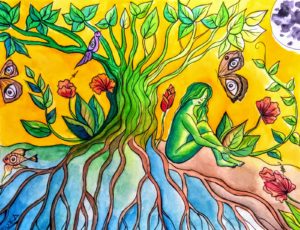In Nepal and India, and many other countries I have yet to visit, I learned to take my shoes off before entering a household. The weaving streets of the world outside the home is a different realm; removing the shoes feels like crossing over a threshold. In Varanasi, I walked through streets bustling and busy with their own method of chaos. There were pigs and goats in t-shirts, dogs and cows, fluttering bags and poo patties, women who sweep every morning and rishis, the holy ones, who walk with their orange clothing and long beards. Walking through the streets of a place, like riding the bus, is one of my favorite ways to understand somewhere. The street is a microcosm of life. It holds the footprints of the people who journey.

Varanasi in particular is a city of alleyways where a bicycle or motorcycle could pop out of five-foot opening at any moment. The dexterity and maneuverability of drivers outperforms even the most experienced of NYC drivers. Varanasi is also a city of extremes, of movement fast and slow, where the holy are the begging, where blue Lord Shiva is worshipped with the sunrise, where, in the words of my friend, every man is a king. Whether or not every woman is a queen is a topic for another essay. Varanasi is a city of darkness and a city of light. To say one and not the other, a wise professor told me, is false. Both extremes exist here: without light, there is no dark; without darkness, there is no life.

The Ganga, the Mother River of India, is one of the sources of life and light. I write Ganga intentionally. While there, I learned that Ganges is the British corruption of the true pronunciation. Ganga-ji (“Ji” is a term of respect given to elders, teachers, and, in this case, the deity of the Ganga) was converted to Ganges by the British mouths that couldn’t hold such a string of sounds and so, like many legacies of colonization, globalization, and the dynamics of change, the truth of the past is rewritten. Many Indians still refer to the Ganga as Ganges as that is what they, too, were taught growing up. For me as a foreigner, I was encouraged by my co-leader, an Indian man from Varanasi, to use the name Ganga as a way of connecting to the culture. Mother Ganga, the goddess who springs from the Himalayas, is the life force of the country, and yet, she experiences the weight of human presence and pollution. Light and darkness in the waters.

For decades, scientists have been putting out information to prove how polluted the waters have become. Specifically regarding drug-resistant bacteria, there is a fear that the Ganga is no longer safe for bathing. And yet, that is not acceptable in the Indian worldview. The Ganga is holy water. Bacteria, pollution be damned. Folks still bring jugs to fill with the water to bring back home. In Varanasi, every day, hundreds, if not thousands, visit the water’s edge to bathe. They descend the ghat—the accordion steps that unroll like a tongue into the water below—and the Ganga flows along at her own pace. During dry season, there is not much of a current, but during the rainy season, I saw the white markings, dozens of meters high, showing just where the Ganga has flooded the centuries-old buildings of Varanasi. In those rainstorms, she sweeps through streets without pause or apology. She is the quiet, as well as the force beneath the surface.

Nowadays, the river is broken into waves caused by three types of boats. There are smaller boats still rowed by young men who have become apt entrepreneurs, medium-sized boats with puff-emitting electric motors, and, finally, a large ferry boat. I was shocked to see such a thing. This multiple-storied boat floats the Ganga at night for the sunset aarti, or ceremony. It seemed like an object emerging from a surrealist painting, an image I couldn’t quite compute against the backdrop of bricked buildings and mosque minarets and Hindu temples carved of sandstone. The ferry overshadows both the present and the past, bringing with its tooting horn the imposing force of the future.

But many things refused to be changed. The sunrise ceremony is one of them. At 4:45am I woke, and by 5:00 was down by the edge of the river with dozens of others, locals and foreigners alike. The morning aarti begins with women singing mantras, walking slowly in a line, while someone plays the tabla, a drum set of bass and tenor. Young men file onto the stage which is set up overlooking the river to perform a sun dance. Each man holds a brass cobra as well as a multi-tiered candelabra that looks like a ten-layered golden cake. The candles are all lit beforehand, and the men raise the fire structures above their heads, circling them, everyone in sync in the imperfect way of humans. One man is a little slow, another too fast.

The procession lasts for thirty minutes and ends with celebration. As soon as the light breaches the water’s edge, the sun begins to speed up as if it’s being summoned by some invisible hand high in the sky. To me, it appears the sun is caught on a fishhook, and the Divine—perhaps Brahman for Hindus, or Allah for Muslims, or God for Christians or Jews, or Nirvana for Buddhists– is the one fishing for light. Day after day, that fisher in the sky reels up the sun from the east, then releases it back down to the west, knowing they will meet again. The ultimate catch and release. When one begins to see sunrise as a ceremony, a matrix of alleyways as a microcosm of life, the removing of shoes as a crossing over, one might see ceremony in everything. When life is lived with that perspective, everything can be seen as divine.




